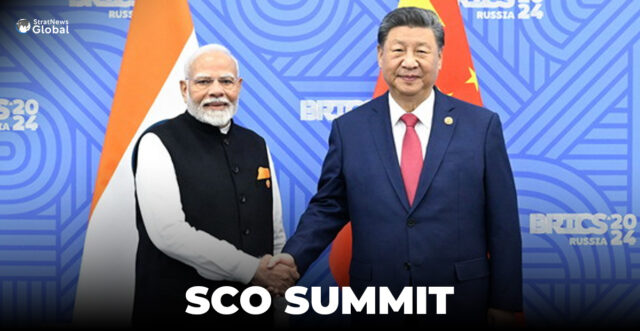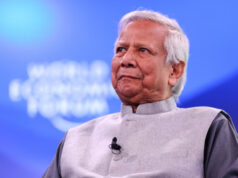As Prime Minister Narendra Modi prepares to travel to China for the Shanghai Cooperation Organisation (SCO) summit from August 31 to September 1—his first visit to the country since the deadly Galwan Valley clash in June 2020—questions are mounting about how India plans to navigate its complex relationship with Beijing inside multilateral settings.
A new scholarly analysis sheds light on how New Delhi has, in fact, already been doing so: not through overt confrontation, but through calculated, forum-specific forms of soft balancing.
The argument is laid out by Ian Hall in his article “India’s China strategy after Galwan: minilateral and multilateral soft balancing in the Indo-Pacific”, published in International Affairs by Oxford University Press on behalf of The Royal Institute of International Affairs. Hall contends that the Galwan clash marked not just a military escalation, but a turning point in India’s overall China strategy—prompting a shift away from “evasive balancing” toward a more deliberate effort to check China’s influence through non-military tools within shared institutions.
According to Hall, India’s behaviour since Galwan reflects a sophisticated soft balancing approach, using multilateral and minilateral platforms to frustrate, delay or constrain China’s ability to pursue its strategic objectives. These tactics—deployed in forums like the RIC (Russia–India–China), BRICS, the SCO and IBSA—are tailored to each setting but share a common logic: limiting China’s room to manoeuvre while avoiding outright rupture or escalation.
Among these, the SCO stands out—particularly in light of Modi’s impending visit. Hall points out that India has long used the SCO to push back against Chinese initiatives, most notably the Belt and Road Initiative (BRI), which New Delhi has consistently refused to endorse in joint communiqués. But after Galwan, India’s approach hardened.
Hall describes India’s recent SCO conduct as trivialization—remaining formally engaged but deliberately reshaping the agenda to sideline Beijing’s interests. Prime Minister Modi’s own “SECURE” framework, rolled out at a previous SCO summit, emphasized issues like terrorism, connectivity, and sovereignty, effectively contrasting with China’s BRI-centric development narrative.
India’s chairmanship of the SCO in 2023 further deepened this approach. Hall notes that New Delhi used its turn to highlight concerns that resonated with Central Asian partners—such as food security and regional stability—while downplaying or omitting China-led projects. At the same time, India continued to publicly confront China over its LAC posture through statements made on the sidelines of SCO meetings, underlining that engagement in multilateral formats did not imply normalization of bilateral relations.
This pattern, however, is not unique to the SCO. Hall documents similar post-Galwan strategies in other forums, beginning with the RIC trilateral. There, India applied a blunt form of soft balancing: denial. It delayed meetings, withheld consent for joint statements, and froze meaningful engagement. While Russia, sometimes with China’s support, sought to reactivate the format, India demurred—sending a clear signal that business-as-usual would not resume while the border situation remained unresolved. In one instance, even when Russia offered to host a leaders’ summit to “break the ice,” New Delhi declined.
Official Indian statements made the rationale explicit. In 2023, the Ministry of External Affairs linked India’s absence from RIC activity directly to the unresolved border situation. As Hall notes, this tactic denied China both legitimacy and visibility, using silence and non-engagement as tools of restraint.
In the BRICS grouping, India adopted a different soft balancing tool: delay. Particularly during China’s 2022 chairmanship, New Delhi pushed back against Beijing’s push to expand the bloc, which China hoped to shape into a more overtly anti-Western platform. While India did not block expansion outright, it insisted on further consultation and slowed down the process. A final agreement on new members only emerged a year later—after China had relinquished the chair.
This resistance, Hall argues, was not incidental. Indian officials, including the prime minister, used public remarks at BRICS meetings to highlight principles like respect for sovereignty and opposition to the politicisation of counterterrorism—clear, if oblique, references to Chinese conduct. Yet India still participated in summits, issued joint declarations, and advanced its own agenda, notably on development and financial reform. The tactic here was to remain present, but to steer the pace and character of the forum in a direction less favourable to Beijing.
In the G20 context, India revived the IBSA dialogue with Brazil and South Africa—a move Hall identifies as a fourth soft balancing method: exclusion. By working within a like-minded, democratic trio, India created a mini-platform free of Chinese influence. This allowed for coordination on global governance issues without Beijing’s presence, while reinforcing India’s multilateral credentials. Notably, this move did not challenge the G20 directly, but it subtly rebalanced its internal dynamics.
What emerges from Hall’s analysis is a coherent and calibrated strategy. India’s post-Galwan approach does not rely on alliances or military buildups, but on institutional positioning and tactical diplomacy. It is not disengagement, but differentiated engagement—denying space in one forum, delaying decisions in another, trivialising agendas elsewhere, and building coalitions where China is absent.
This reflects, Hall argues, a pragmatic understanding of India’s constraints. Direct confrontation with China carries military and economic risks, especially given the asymmetry in capabilities and continued trade dependencies. But soft balancing offers a way to compete—quietly, consistently, and across multiple arenas—without crossing the threshold into conflict.
In October 2024, following a bilateral meeting between Modi and Xi on the sidelines of the BRICS summit in Kazan, both sides announced a deal to disengage troops in Depsang and Demchok—the last major flashpoints in Ladakh where Indian patrolling rights had been denied since 2020. Whether this was the result of India’s soft balancing in multilateral forums, its hard balancing on the LAC, economic sanctions, or external strategic pressures remains unclear, argues Hall.
But having struck that deal, New Delhi may now adjust the tempo of its diplomatic balancing—though it is unlikely to abandon it entirely, given persistent mistrust and continued military deployments along the frontier.
As Modi prepares to share a table with Xi Jinping at the SCO summit in China later this month, the stage will offer more than handshakes and photo-ops. It will also provide a fresh opportunity to observe the very tactics Hall describes in action. Will India reiterate its objections to Chinese projects? Will it spotlight its own strategic agenda? Or will it engage in visible diplomacy while quietly blocking or blunting Chinese initiatives behind the scenes?
What is clear from Hall’s analysis is that India no longer treats multilateral forums as neutral ground. Since Galwan, they have become contested spaces—arenas where power is not just exercised through troops or tariffs, but through attendance, agendas, communiqués and significant silences.
In a career spanning three decades and counting, Ramananda (Ram to his friends) has been the foreign editor of The Telegraph, Outlook Magazine and the New Indian Express. He helped set up rediff.com’s editorial operations in San Jose and New York, helmed sify.com, and was the founder editor of India.com.
His work has featured in national and international publications like the Al Jazeera Centre for Studies, Global Times and Ashahi Shimbun. But his one constant over all these years, he says, has been the attempt to understand rising India’s place in the world.
He can rustle up a mean salad, his oil-less pepper chicken is to die for, and all it takes is some beer and rhythm and blues to rock his soul.
Talk to him about foreign and strategic affairs, media, South Asia, China, and of course India.





